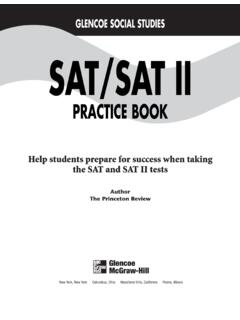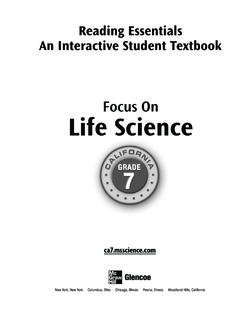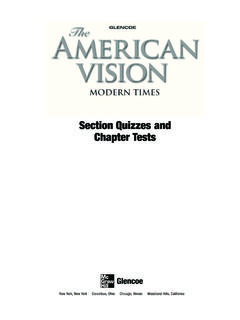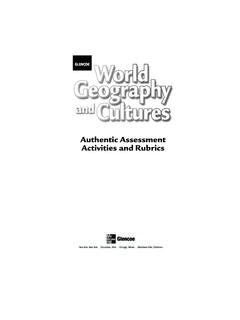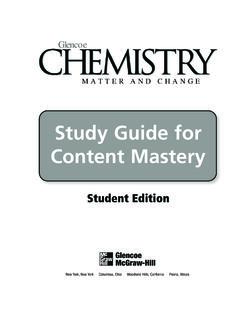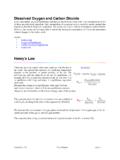Transcription of Glencoe Physical Science
1 ConsultantDouglas Fisher, PhysicalScienceCopyright by the McGraw-Hill Companies, Inc. All rights reserved. Permission is granted to reproduce thematerial contained herein on the condition that such material be reproduced only for classroom use; be providedto students, teachers, and families without charge; and be used solely in conjunction with Glencoe other reproduction, for use or sale, is prohibited without prior written permission of the all inquiries to: Glencoe /McGraw-Hill8787 Orion PlaceColumbus, Ohio 43240-4027 ISBN 0-07-869580-5 Printed in the United States of America1 2 3 4 5 6 7 8 9 047 08 07 06 05 About the ConsultantDouglas Fisher, , is a Professor in the Department of Teacher Education at San Diego State University. He is the recipient of an International Reading Association Celebrate Literacy Award as well as a Christa McAuliffe award for Excellence in Teacher Education. He has published numerous articles on reading and literacy, differentiatedinstruction, and curriculum design as well as books, such as ImprovingAdolescent Literacy: Strategies at Workand Responsive Curriculum Design in Secondary Schools: Meeting the Diverse Needs of has taught a variety of courses in SDSU s teacher credentialing program as well asgraduate-level courses on English language development and also has taught classes in English, writing, and literacy development to secondary school Physical ScienceiiiNote-taking viiUsing Your Science Notebook.
2 ViiiChapter 1 The Nature of ScienceChapter Preview .. 12 Chapter 2 MotionChapter Preview .. 24 Chapter 3 ForcesChapter Preview .. 36 Chapter 4 EnergyChapter Preview .. 384-2 .. 44 Chapter 5 Work and MachinesChapter Preview .. 495-3 .. 56 Chapter 6 Thermal EnergyChapter Preview .. 68 Chapter 7 ElectricityChapter Preview .. 707-2 .. 76 Wrap-Up .. 80 Chapter 8 Magnetism and Its UsesChapter Preview .. 818-1 .. 828-2 .. 92 Chapter 9 Energy SourcesChapter Preview .. 104 Chapter 10 WavesChapter Preview .. 10910-3 .. 116 Chapter 11 SoundChapter Preview .. 11811-2 .. 12111-3 .. 130 Chapter 12 Electromagnetic WavesChapter Preview .. 13212-2 .. 142 Chapter 13 LightChapter Preview .. 156 Copyright Glencoe /McGraw-Hill, a division of The McGraw-Hill Companies, Physical ScienceChapter 14 Mirrors and LensesChapter Preview .. 168 Chapter 15 Classification of MatterChapter Preview.
3 176 Chapter 16 Solids, Liquids, andGasesChapter Preview .. 188 Chapter 17 Properties of Atoms and the Periodic TableChapter Preview .. 200 Chapter 18 Radioactivity andNuclear ReactionsChapter Preview .. 20118-1 .. 20218-2 .. 214 Chapter 19 Elements and TheirPropertiesChapter Preview .. 226 Chapter 20 Chemical BondsChapter Preview .. 238 Chapter 21 Chemical ReactionsChapter Preview .. 252 Chapter 22 Solutions Chapter Preview .. 266 Chapter 23 Acids, Bases, and SaltsChapter Preview .. 278 Chapter 24 Organic CompoundsChapter Preview .. 292 Chapter 25 New Materials Through ChemistryChapter Preview .. 304 Copyright Glencoe /McGraw-Hill, a division of The McGraw-Hill Companies, Physical SciencevYour notes are a reminder of what you learned in class. Taking goodnotes can help you succeed in Science . These tips will help you takebetter notes. Be an active listener. Listen for important concepts.
4 Pay attention to words, examples, and/or diagrams your teacher emphasizes. Write your notes as clear and concise as possible. The followingsymbols and abbreviations may be helpful in your note-taking. Use a symbol such as a star ( ) or an asterisk (*) to emphasisimportant concepts. Place a question mark (?) next to anything thatyou do not understand. Ask questions and participate in class discussion. Draw and label pictures or diagrams to help clarify a or Symbol orPhraseAbbreviationfor or Symbol orPhraseAbbreviationand+approximately therefore versusvsNote-Taking TipsNote-Taking Don ts Don t write every word. Concentrate on the main ideas and concepts. Don t use someone else s notes as they may not make sense. Don t doodle. It distracts you from listening actively. Don t lose focus or you will become lost in your Glencoe /McGraw-Hill, a division of The McGraw-Hill Companies, Physical Scienceatmospheresalinityphotosynthesist hermoclineaccumulate NewVocabularyReviewVocabularyAcademicVoc abularyName Date OceansSection 1 Ocean Water76 OceansAcademic Standard :Understand and describe the scales involved in characterizing Earth and its that Earth is.
5 Also covers: Section 1 of your book. Write three questions thatcome to mind from reading the headings and the illustration answers will vary, but may include questions about formation, composition of ocean water, or water and your book or a dictionar y to define s air, which is made of a thin layer of gases, solids, and liquids; forms a protective layer around the planet and is divided into five distinct your book to define the following measure of dissolved solids, or salts, in seawaterthe process in which organisms use sunlight, water, and carbon dioxide to make food and oxygenlayer of ocean water that begins at a depth of about 200 m and becomes progressively colder with increasing depthUse your book or a dictionar y to define increase gradually in quantity or number; to gather or pile upUsing Your Science NotebookThis note-taking guide is designed tohelp you succeed in learning sciencecontent. Each chapter includes:Construct the Foldable as directed at the beginning of this You ReadBefore you read the chapter, respond to these an Aif you agree with the a Dif you disagree with the Date Oceans75 Write three questions that you would ask a scientist studying ocean Journal Ocean water is about the same temperature all over the world.
6 Global winds cause density currents tomove the ocean water. The Moon s gravity and rotation affect the tides. Wave erosion affects marine life in coastal YouOceansReadOutline the section on dissolved three most important gases are,, layer gets oxygen from atmosphere and below 200 m very little dioxide directly from off by organisms during with water molecules to form carbonic gas in ocean than any other bacteria combine nitrogen with oxygen to form nitrates that nutrients for building blocks for plant & animal have three temperature layer receives solar near the equator; solar rays strike more near the poles; solar rays strike at lower layer extremely cold waternitrogencarbon dioxideoxygenSection 1 Ocean Water (continued)I found this informationon page .IN SE, p. 197IN RE, p. 105 Name Date 78 OceansScuba divers don t need the pressurized suits that deep-sea divers do.
7 Hypothesize why deep-sea divers must use special suits, the pressure of the water above the diver would crush him or the CONNECTITL anguage-based Activities Activities cover the content in your Science book includingvocabulary, writing, note-taking, and problem Journal Write about what you Guide/KWL chartsThink about what you already knowbefore beginning a lesson and identify what you would like to learn from Activities These activities to help you tothink about what you re learning and make connections to your DevelopmentVocabulary words help you to betterunderstand your Science lessons. Learning the Academic Wordscan help you score higher on standardized Glencoe /McGraw-Hill, a division of The McGraw-Hill Companies, Physical ScienceviiOrganizeeach wave characteristic in the Venn diagram to showwhether it is a trait of tides, waves created by wind, or and neap tides in the boxes below. Use the figure in your book to help you. Include the Sun, the Moon, and Earth in your model by the Sun s and Moon s gravityTidesWaves Createdby Windcreated by windsbreakershigher different times of the monthBothcontain crests and troughswavelength can be measuredwave height can be measured breakers higher different times ofthe month contain crests and troughs wavelength can be measured created by the Sun s and theMoon s gravity created by winds wave height can be measuredSection 3 Waves (continued)TidesI found this informationon page.
8 IN SE, p. 207IN RE, p. 115I found this informationon page .IN SE, p. 207IN RE, p. 115 Accept all Date 84 OceansSpring TideNeap TideSpring tides occur Neap tides occur when the Sun, Moon when the Sun, Moon, and Earth and Earth are at are angles. Ocean water is about the sameDIN SE, p. 198temperature all over the RE, p. 106 Global winds cause density currents toDIN SE, p. 202move the ocean RE, p. 110 The Moon s gravity and rotation affect AIN SE, p. 207the RE, p. 115 Wave erosion affects marine life inAIN SE, p. 208coastal RE, p. 114 OceansChapter Wrap-UpNow that you have read the chapter, think about what you have learned and complete the table below. Compare your previous answers to an Aif you agree with the a Dif you disagree with the Date OceansAfter YouReadIdentify three important ideas you learned in the all reasonable this checklist to help you the information you included in your your Science Notebookon this the definitions of vocabulary daily homework the chapter and review the charts, graphs, and the Self Check at the end of each over the Chapter Review at the end of the information on density currents.
9 In the Question spacesbelow, turn the bold-faced text headings into questions. The first one has been done for you. Then answer your CurrentsQuestion:How are density currents formed ?Answer:Seawater becomes more dense when it gets cold orsalty. Warm water becomes more dense as it evaporates leaving salt. Dense water sinks creating and Salty WaterQuestion:What is the affect of cold and salty water?Answer:If water freezes, dissolved salts are left behind. Unfrozenwater is dense because it is cold and salty, causing it to sink then flow stops or slows. Cold, salty water flows out to sea as warm water moves Currents and Climate ChangeQuestion:How are currents affected by climate?Answer:If temperatures rise enough, ice melts. Salinity is reduced as glaciers steps in the process of 2 Ocean Currents and Climate (continued)Density CurrentsI found this informationon page .IN SE, pp. 202 203IN RE, pp. 110 111 UpwellingI found this informationon page.
10 IN SE, p. 204IN RE, p. 111 Name Date cause surface water to move away from the land in the Coriolis water rises in place of surface water as it moves awayfrom , deep currents containing nutrients usually replacesurface Ni o events cause changes in the temperature of theocean Wrap-UpThis brings the information together for you. Revisiting what you thought at the beginning of the chapter providesanother opportunity for you to discuss what you have OrganizersA variety of visual organizers help you to analyze and summarize informationand remember Based on the Cornell Two-Column FormatPractice effective note-taking through theuse of graphic organizers, outlines, and written Checklist This list helps you assess whatyou have learned and preparefor your chapter Glencoe /McGraw-Hill, a division of The McGraw-Hill Companies, Glencoe /McGraw-Hill, a division of The McGraw-Hill Companies, the Foldable as directed at the beginning of this Nature of ScienceBefore You ReadBefore you read the chapter.

